The 5 Best Inflatable Bike Helmets of 2025
Safety That Packs Down Small
You’ve spotted those sleek, collapsible helmets popping up on your commute, haven’t you? They’re not just a passing trend. Bike helmets, inflatable ones, combine real CPSC-certified protection with the ability to shrink down by 40% when you’re off-wheel.
No more awkward helmet-carrying or risking your safety because you can’t be bothered with bulk.
Want to know which ones won’t leave your head (or wallet) deflated in 2025?
Key Takeaways
- Airnoggin Inflatable Helmet shrinks 60% when deflated while meeting US/EU safety standards with patented soft foam protection.
- Inflatable helmet technology offers comparable protection to traditional hard helmets while solving storage and portability challenges.
- Quality inflatable helmets maintain CPSC or EN 1078 certifications for both linear and rotational impact protection when fully inflated.
- Look for secure valve systems, proper inflation specifications, and adjustable retention systems for optimal safety and comfort.
- Most inflatable helmets have a three-year lifespan from manufacture date and should be inspected regularly for wear.
Inflatable Helmet for Bike & Scooter Riders
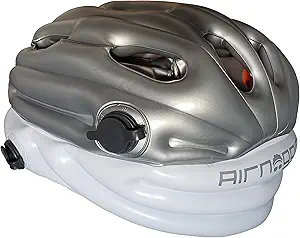
If you’re the type who values both safety and convenience—without lugging around a bulky foam shell—the Airnoggin Inflatable Helmet might just revolutionize your commute.
This ingenious noggin protector shrinks by 60% when deflated, slipping effortlessly into your bag while still meeting rigorous US and EU safety standards. Its patented soft foam protection rivals traditional hard helmets, though the one-size-fits-most design might squeeze larger craniums.
Just inflate, secure, and pedal with confidence—but check that manufacture date. With a three-year lifespan from production, you’ll want to maximize your investment before your protection deflates permanently.
Best For: Urban commuters, occasional cyclists, and e-scooter riders who prioritize portability and need a space-saving helmet solution they can easily stow when not riding.
Pros:
- Collapses to 40% of its original size, making it easy to store in bags, backpacks, or briefcases when not in use
- Exceeds safety standards for both US and EU regulations, providing legitimate protection despite its inflatable design
- Lightweight at just 1.6 pounds and more comfortable than traditional hard helmets for many users
Cons:
- Limited 3-year lifespan from manufacture date means potential buyers should check production dates before purchasing
- One-size design may feel too snug for riders with larger heads, with no sizing options available
- Some users report difficulty inflating the upper valve due to padding interference
Schwinn Thrasher Bike Helmet for Adults
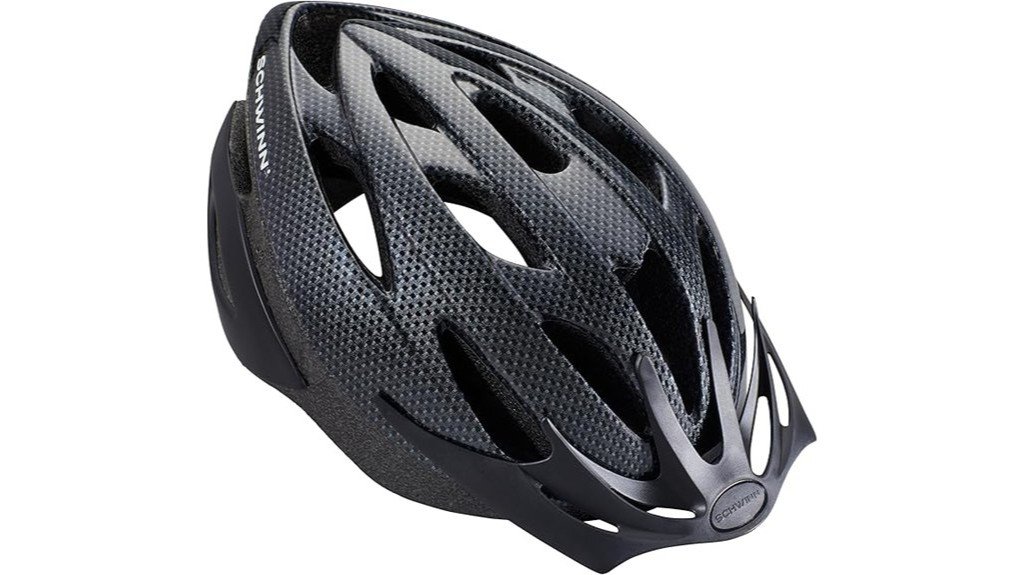
Cyclists seeking the perfect balance of safety and comfort will find the Schwinn Thrasher a rejuvenating blast from the traditional helmet past. It’s certainly not inflatable, but this dual-microshell wonder weighs a feathery 13.44 ounces while meeting all CPSC safety standards.
The Thrasher’s 21 flow vents will keep your head cooler than a cucumber in Alaska, while the 360° Comfort system lets you dial in your perfect fit faster than you can say “aerodynamic.” At 58-62cm, it accommodates most adult noggins.
For $25, you’re getting the #1 bestselling helmet with a 4.7-star rating from over 23,000 fellow cyclists. Traditional? Yes. Inflatable? No. Effective? Absolutely.
Best For: Casual to serious adult cyclists looking for a reliable, lightweight, and well-ventilated helmet with adjustable fit features at an affordable price point.
Pros:
- Highly adjustable with 360° Comfort system featuring dial fit knob and side straps for a secure, custom fit
- Excellent ventilation with 21 air vents to keep heads cool during rides
- Lightweight yet durable construction with dual microshell layers and full-coverage EPS foam that meets CPSC safety standards
Cons:
- May fit snugly for those at the upper end of the size range (62 cm)
- Some reports of quality control issues including missing trim or packaging problems
- Not suitable for children under 14 years of age
Adult Cycling Bike Helmet, Lightweight Unisex
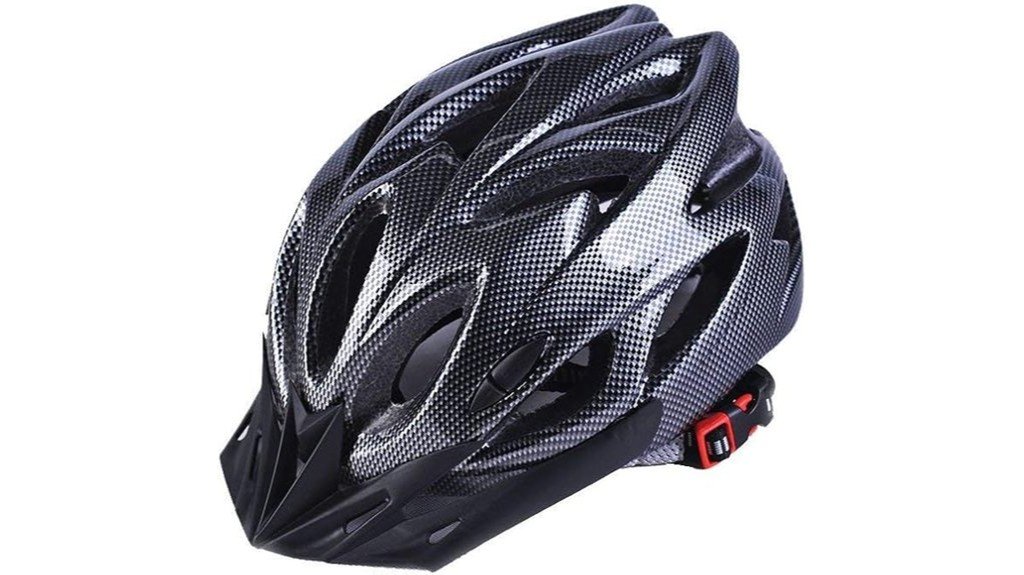
Safety meets comfort in the Adult Cycling Bike Helmet by R.X.Y, where 18 strategically placed air vents keep your head cool during those multi-hour weekend rides.
You’ll appreciate the easy-dial adjustment system that fits heads between 22.4-24.4 inches—even accommodating larger noggins up to 61cm. At just 0.21kg, you won’t feel like you’re balancing a bowling ball up there.
With its polycarbonate shell and expanded polystyrene interior, it’s built for protection without the premium price tag. Customers consistently rate it 4.5/5, calling it a steal compared to $70-$90 alternatives.
Removable pads mean no more “eau de weekend warrior” lingering in your helmet.
Best For: Adult cyclists seeking an affordable, lightweight helmet with excellent ventilation for casual rides and everyday use, fitting head sizes from 22.4-24.4 inches (57-62 cm).
Pros:
- Exceptional airflow through 18 vents keeps head cool during extended rides
- Lightweight design (0.21 kg) prevents neck fatigue during longer cycling sessions
- Highly adjustable fit system with easy-to-use dial accommodates various head shapes, including larger sizes
Cons:
- Some uncertainty among users about real-world impact protection despite solid construction
- Limited style options with only black color available
- Occasional shipping/delivery issues reported by customers (carrier-related problems)
Road Bike Helmet for Adult Men & Women, Adjustable Lightweight Design
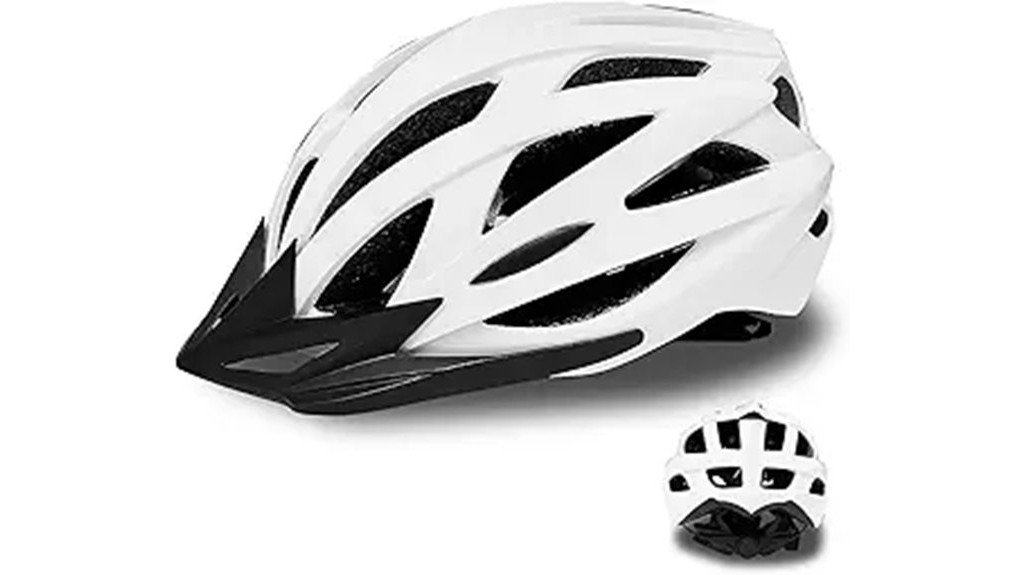
Modern commuters seeking both style and protection need search no further than our Road Bike Helmet for Adult Men & Women.
You’ll appreciate the CPSC-certified safety wrapped in a sleek, high-gloss white shell that keeps you visible day or night. The 265g featherweight design won’t strain your neck during long rides, while 24 strategic vents keep your head cool when temperatures aren’t.
Adjustability? It’s built in. The knob retention system and repositionable chin strap fit heads from 22-24.5 inches, ensuring a secure ride without the wobble. Pop off the visor to shift seamlessly from mountain trails to city streets. The removable liner? Just wash and go.
Best For: Safety-conscious urban cyclists and recreational riders who value lightweight comfort, versatility between road and trail use, and need a helmet that fits a wide range of head sizes.
Pros:
- CPSC-certified safety features with impact-absorbing EPS foam and durable PC shell provide reliable protection
- Ultra-lightweight design (265g) with 24 ventilation vents ensures all-day comfort even during hot weather rides
- Versatile adjustability with knob system and removable visor allows customization for different head sizes and riding styles
Cons:
- Limited to head circumferences between 22-24.5 inches, which may not accommodate those with particularly large heads
- Only available in white, limiting style options for those who prefer darker colors or patterns
- No mentioned advanced features like MIPS technology or integrated lights that some premium helmets offer
Bell Revolution MIPS Bike Helmet
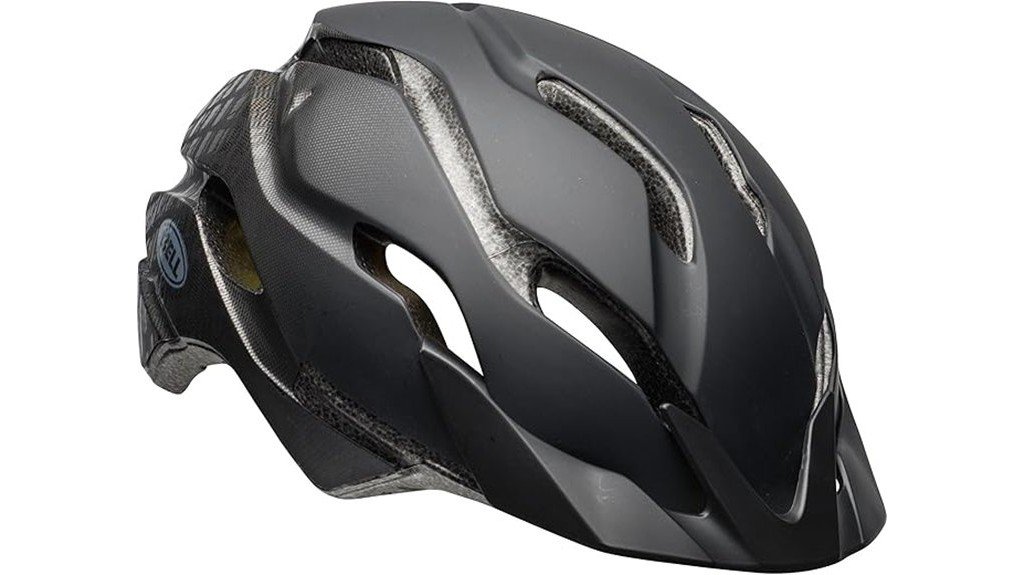
The Bell Revolution MIPS offers protection without demolishing your wallet, proving that safety tech doesn’t require a second mortgage. At $30, you’re getting MIPS protection that redirects impact energy, potentially saving your skull during crashes.
The one-handed dial adjustment makes fitting a breeze, though large-headed cyclists might find it snug at maximum extension. Weighing just 0.75 pounds, you’ll barely notice it’s there during all-day rides.
Several users report this helmet literally saved their lives in collisions. Just watch for the occasionally fragile visor and peeling shell in intense sun—minor compromises for budget MIPS protection that works when it matters.
Best For: Budget-conscious cyclists seeking MIPS impact protection technology in an all-purpose helmet that works for road, mountain, and recreational riding.
Pros:
- Features MIPS protection technology that redirects energy during impacts at an affordable $30 price point
- Lightweight design (0.75 pounds) with one-handed dial adjustment system for comfortable all-day wear
- Proven real-world safety performance with multiple users reporting it protected them in serious crashes
Cons:
- May fit too tight for riders with larger head sizes even at maximum adjustment
- Visor reportedly breaks off easily and shell can peel when exposed to intense sunlight
- Some users find the straps uncomfortable and report small parts (like attachment ends and O-rings) falling off
Factors to Consider When Choosing an Inflatable Bike Helmet
When shopping for an inflatable bike helmet in 2025, you’ll need to navigate through a maze of safety certifications, portability features, and material specifications. You’re investing in a product that’s both your brain’s bodyguard and a fashion statement, so don’t skimp on examining inflation mechanisms and adjustment systems. The perfect inflatable helmet balances certified protection with the convenience of compact storage, all while fitting your head like it was custom-made for your cycling adventures.
Safety Certification Standards
Maneuvering the labyrinth of safety certifications for inflatable bike helmets requires both diligence and skepticism—you can’t just trust a product that resembles a fancy balloon to protect your precious brain.
First, verify compliance with CPSC standards (U.S.) or EN 1078 (EU)—look for these exact codes on the packaging. Don’t fall for vague claims like “safety tested”; demand explicit certification statements and identification of the testing laboratory.
Check that your inflatable wonder has passed both linear and rotational impact tests in its fully inflated state. The valve system must be included in certification testing too—after all, what good is a deflated lifesaver?
Finally, note the manufacture date and expected lifespan. These high-tech noggin-protectors typically expire after three years, regardless of how futuristic they look.
Portability And Storage
Beyond safety certifications lies the practical reality of living with your helmet—portability makes or breaks your daily commitment to brain protection.
Today’s inflatable options collapse to a mere 40% of their full volume, easily disappearing into your fanny pack or briefcase like a magician’s prop. At 1-2 pounds—comparable to traditional helmets without the bulky footprint—you’ll barely notice it’s there until you need it.
Consider the valve design before purchase; some require awkward arm contortions worthy of a yoga instructor just to inflate. And don’t forget the invisible expiration date hovering about three years from manufacture. Nothing says “poor planning” like discovering your deflated brain guardian has aged out right when you need it most.
Material Durability
Material integrity matters as much as storage convenience—your deflated helmet tucked away in a bag won’t help if it fails upon inflation. Scrutinize that PVC or TPU outer shell thickness; thin materials invite punctures faster than cyclists find potholes.
UV exposure turns your safety gear into crusty garbage, so hunt for UV-resistant polymers with specified service lives. Those fashionable folding patterns? Each crease weakens structural integrity.
Don’t let valve systems be your downfall—metal or reinforced valves outperform flimsy plastic that gives up after three uses. And beware the silent killer: air retention. Quality models maintain pressure through heat, cold, and that unexpected downpour.
Test inflation cycles when possible—your helmet should survive more deflate-inflate rounds than your average political promise. Remember, durability isn’t just about surviving crashes—it’s about being ready when one happens.
Ease Of Inflation
Nobody wants to pass out while blowing up their helmet like an overworked birthday party clown. Your inflation experience hinges primarily on valve design—look for models with dual valves or wider diameters that gulp air efficiently rather than sipping it painfully slow.
Check the target pressure requirements in advance. Higher-pressure designs might demand a proper pump, rendering your lung power irrelevant. Clever one-way valves prevent that soul-crushing moment when half your air escapes during adjustment, while quick-release buttons make deflation a breeze.
Valve placement matters tremendously—those hidden under thick padding or perched atop your head will have you contorting like a yoga instructor mid-ride. Smart manufacturers include inflation accessories or guarantee compatibility with standard bike pumps and CO2 cartridges for roadside convenience.
Fit And Adjustability
While professional cyclists might debate tire pressure for hours, the fit of your inflatable helmet deserves even more scrutiny—it’s literally the difference between brain preservation and a medical misadventure.
Start with circumference—measure your noggin’s widest point and match it to a helmet that sits level without mimicking a bobblehead doll. Today’s inflatable marvels come with sophisticated retention systems—dials, tensioners, or bladders—that lock your lid in place during those inevitable gravity experiments.
Pay obsessive attention to inflation specs; too much air turns your helmet into a basketball, too little negates its protective qualities. Multiple adjustment points at chin, sides, and rear let you customize fit around your uniquely shaped skull.
The ultimate test? Buckle up, then headbang like you’re at a metal concert—if it moves more than an inch, keep adjusting.
Lifespan Considerations
Unlike your milk’s expiration date that you might casually ignore, your inflatable helmet’s lifespan demands serious attention. Most manufacturers recommend retiring these protective bubbles after just three years from manufacture—and that’s under ideal conditions.
Your helmet ages faster than your favorite wine, but without the improved taste. UV rays, heat, moisture, and those inflate-deflate cycles all accelerate material degradation. Before each ride, give your lid a quick inspection for cracks, discoloration, or valve leaks—these aren’t aesthetic issues, they’re safety red flags.
Crashed in your helmet? Retire it immediately, even if it looks Instagram-worthy. Invisible damage compromises protection. Store your deflated brain-saver in a cool, dry sanctuary away from sunlight and chemicals, and always track that manufacture date.
Conclusion
You’ve seen the future of head protection, and it’s inflatable! Whether you’re dodging city traffic or stuffing gear into a carry-on, these 2025 marvels have your noggin covered—literally. Remember: the best helmet is the one you’ll actually wear. So grab one of these packable wonders, inflate with confidence, and ride on. Your cranium (and cramped apartment) will thank you.